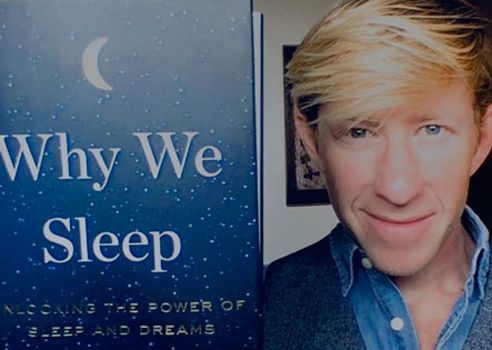Reading time: Less than 2 minutes
I like to share interesting pieces of figurative language I encounter in my reading. I write today about a series of similes from author Matthew Walker….
I’ve had troubled sleep for as long as I can remember. I had a hard time falling asleep as a child; I had a job that required me to work overnight one day a week as a young adult; and, I had to deal with all-night feedings when my triplet children were infants.
Perhaps my history explains why I found the book Why We Sleep by Matthew Walker (picture above), to be so deeply engaging. This New York Times bestseller performs the interesting hat-trick of being interesting, well written and scientifically acute. To me the secret sauce is the author’s ability with figurative language, particularly similes.
Here are my favourite examples:
- Sunlight acts like a manipulating finger and thumb on the side-dial of an imprecise wristwatch.
- Caffeine blocks and effectively inactivates the receptors, acting as a masking agent. It’s the equivalent of sticking your fingers in your ears to shut out a sound.
- FM waves run out of steam quickly, like a muscle-bound sprinter who can only cover short distances.
- You have, in effect become an embodied prisoner, incarcerated by REM sleep.
- Oddly, during the transition from being awake into light stage 1 NREM sleep, the eyes will gently and very, very slowly start to roll in their sockets in synchrony, like two ocular ballerinas pirouetting in perfect time with each other.
- For the first time in our evolution, hominids could consume all the body-immobilized REM-sleep dreaming they wanted, and not worry about the lasso of gravity whipping them down from treetops.
- REM sleep acts as an electrical fertilizer during the critical phase of early life. Dazzling bursts of electrical activity during REM sleep stimulate the lush growth of neural pathways all over the developing brain, and then furnish each with a healthy bouquet of connecting ends, or synaptic terminals.
- Think of REM sleep like an Internet service provider that populates new neighborhoods of the brain with vast networks of fiber-optic cables.
- A long, finger-shaped structure tucked deep on either side of your brain, the hippocampus offers a short-term reservoir, or temporary information store, for accumulating new memories.
- Unfortunately, the hippocampus has a limited storage capacity almost like a camera roll or to use a more modern-day analogy, a USB memory stick.
- Through its therapeutic work at night, REM sleep performed the elegant trick of divorcing the bitter emotional rink from the information-rich fruit.
- The two had found each other one sky-leaking day in Seattle.
An earlier version of this post first appeared on my blog on June 13/19.


